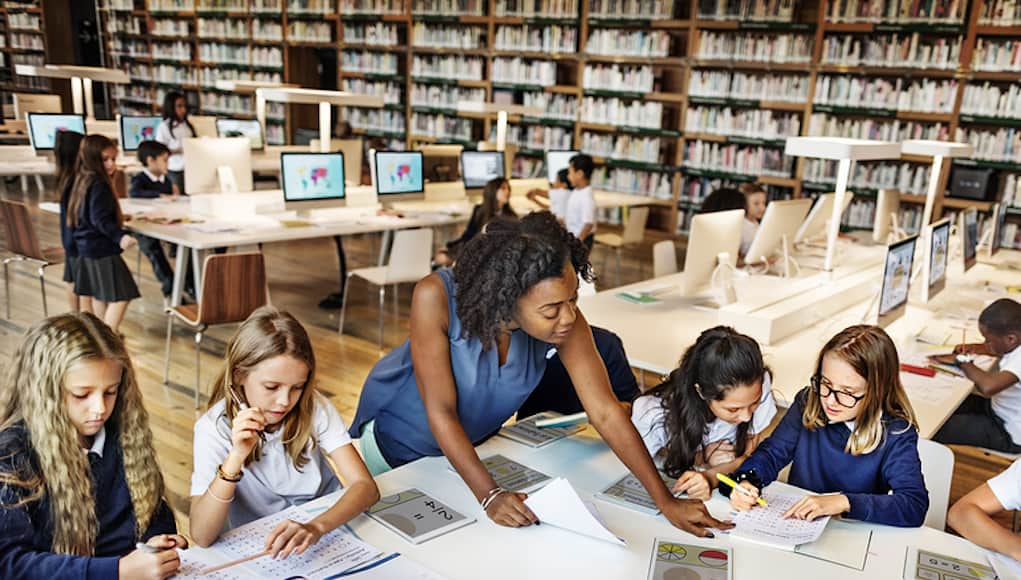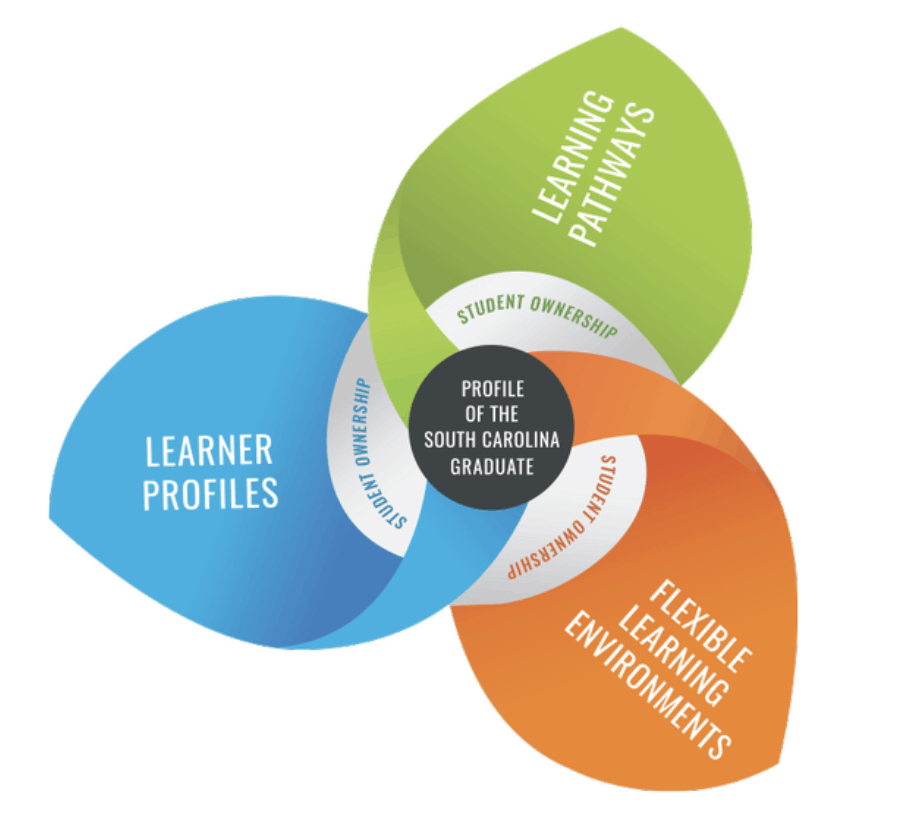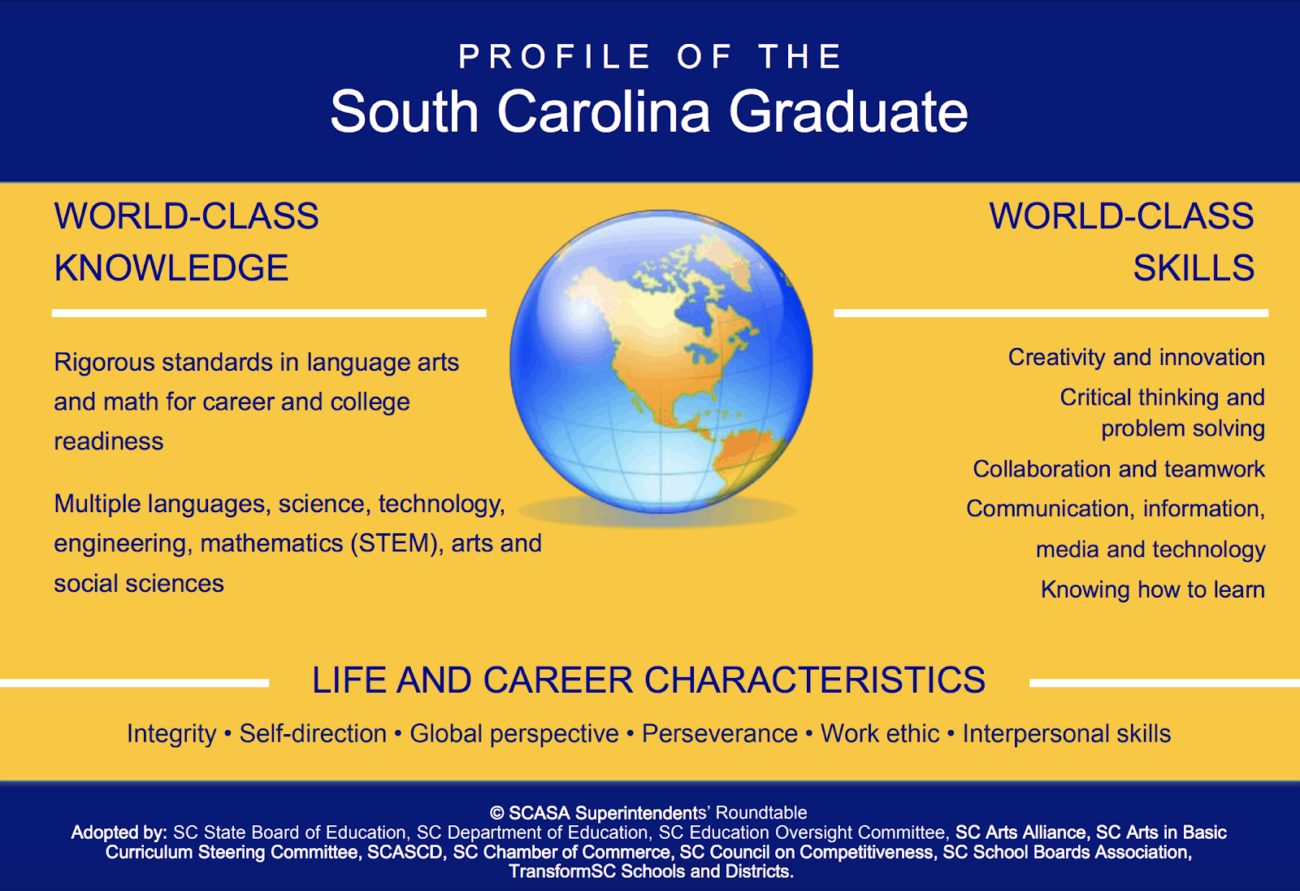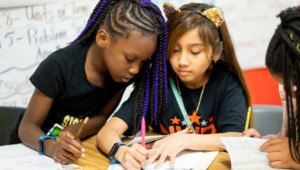South Carolina’s Statewide Movement to Personalize Learning

Across South Carolina, there is a movement to personalize learning for all students. The Department of Education is, of course, committed to ensuring all students graduate prepared for college, work, and life and the personalized learning strategies have become one way to reach this goal. To ensure personalized learning is a priority within the state, and is backed by significant resources, the Department of Education formed the Office of Personalized Learning. Through the work of that office, and in collaboration with local and national stakeholders, a Personalized Learning Framework and South Carolina Profile of a Graduate have been developed and are at various levels of implementation statewide.
| South Carolina Personalized Learning Framework | South Carolina Profile of a Graduate |
  |
  |
Source: South Department of Education
While the state has taken a lead on personalized learning, many local districts have spearheaded their own homegrown initiatives to ensure high-quality learning for all students. The state is on a mission to make sure these districts are not just pockets of excellence but rather learning labs where district leaders and school administrators and teachers can learn. To date there have been two “Personalized Learning Inquiry Labs” held throughout the state and one more, focused on learning pathways in Charleston, is scheduled to occur before the end of the school year. The last inquiry lab was focused on student ownership through flexible learning environments and was hosted by Rock Hill Schools. I was able to visit Rock Hill on the day of their Inquiry Lab and saw the different ways they are locally personalizing.
Saluda Trail Middle School and Project-Based Learning
One of the schools on the inquiry lab tour was Saluda Trail Middle School (Old Pointe Elementary and South Pointe High were also a part of the tour), a STEAM school that in 2015 was recognized as a P21 Exemplar School and in 2016 received AdvancED STEM certification. While the inquiry lab was focused on flexible learning environments, you cannot help but talk about project-based learning at Saluda Trail, it is one of the cornerstones that make this school so great. An in-depth look at how Saluda Trail is implementing PBL can be discussed at another time but one thing to note is that the school follows a design thinking process in every grade. Principal Elissa Cox is in her second year at the school and explained how design thinking shapes the work students do in all their classes, she further noted that at any point a student should be able to tell you where they are in the process.
 |
 |
You see evidence of this when you are visiting classrooms. Not only is the design thinking framework prominently displayed in classrooms, you can hear students talking about the design process as they are in their flexible learning environments.
Flexible Learning Environments are Essential
It just takes a quick walk around the school to notice that flexible learning environments are engrained into the culture of learning. Each environment is intentional with specific learning taking place. To help develop this culture, Saluda Trail’s leadership team turned to Catlin Tucker’s book Blended Learning in Action: A Practical Guide Toward Sustainable Change which states that readers will find:
- “Breakdowns of the most effective classroom setups for blended learning
- Tips for leaders
- Ideas for personalizing and differentiating instruction using technology
- Strategies for managing devices in schools
- Questions to facilitate professional development and deeper learning”
Instructional Coach Becky Funderburk shared that the goal for the school’s blended and flexible learning model is to give students control over time, place, and pace. Tucker’s book has been instrumental in providing strategies for how to effectively implement this goal. What started as a summer reading between Becky and 10 teachers (with corresponding modules in Canvas) has now turned into all teachers going through the book in cohorts throughout the year. The teachers are working on the strategies Tucker outlines in her “Introduction to Blended Learning” video:
- Station Rotation
- Flipped Classroom
- Whole Group Rotation
- Individualized Models
This intentional design, and focus on teacher development to initiate this design process, is evident when visiting Saluda Trail’s classrooms. 7th grade ELA teacher Dr. Julie Marshall shared about how she shifted her classroom to an active learning environment and where students sit in pods discussing their latest projects and ideas. Inside the classroom, discussions continue while students are working in groups or at the Clear Touch board. Dr. Marshall floats around the room answering questions or providing ideas as needed. A theme in this classroom is entrepreneurship, students study actual problems in society based on a quarterly topic. During the visit, the students were anchored by the topic, “change,” and were investigating: 1) genealogy and heroes from the past, 2) business and education design, and 3) the telephone, social media and, society. One visitor asked a student what standard they were currently learning, the student admitted to not knowing but said something powerful: “Dr. Marshall is teaching us about life.” Isn’t that what we hope for with all learning experiences? That they will relate to the real world?
The tour continued with a walk down the Related Arts hallway and into a Robotics classroom where students were perfecting robots they had made.

One group of students was at a table investigating if their robot’s arm had enough force and if the robot was going too fast or too slow. The team tested out their robot and came to the conclusion that the robot was going too slow and the arm did not have enough power. When asked what they could do to resolve this, they walked me to another station — the computers– and told me they could program the robot to go faster, and also give it a bit more power to enable it to push the object off the table. The teacher was present but he was functioning as a facilitator. The students clearly knew he was there to answer questions if they had them, and he examined their robots and the testing and dropped nuggets of wisdom on how they could improve upon their creations, but he never directly guided them with what to do. You could tell he was encouraging them to test and evaluate and then redesign as a part of the overall design process.
Aside from the classroom, Saluda Trails has built in several other flexible spaces where students can learn. Students and teachers can utilize these spaces to work on a variety of projects, going back to the notion of allowing students flexibility in where and how they learn.
| Hallway learning space | Makerspace | AV room for morning announcements, video recording, and Podcasts |
 |
 |
 |
Rock Hill Schools Share Their Knowledge
The Office of Personalized Learning at the South Carolina Department of Education wants participants to not only see innovative schools and classrooms, they also want participants to have the opportunity to deepen their knowledge and unpack what they saw from the experience. Following the school visits Stephanie DiStasio, Director of Personalized Learning, shared that the purpose of her office was to help collaboration happen among schools and districts and these inquiry labs are one way of getting at that.
Teachers and students from the three schools participated in a panel to talk more about their schools and the various learning approaches. The reflections from the teachers and students were honest, encouraging, and provided thinking on why flexible learning is so important. Here are the most salient points.
Reflections from the teacher panel:
- Know Your Students: When designing a flexible learning environment you have to consider where your students are, not all students are at the same level so you have to design activities based on individual personalities and learning styles.
- Be Flexible: Learn how to be flexible. This work will take you out of your comfort zone because you have to learn to a certain extent to let go. Become a facilitator of learning, take a step back and let students learn on their own.
- Direct Teaching is Still Needed: Students still need direct teaching! Workshop models work really well. You can do a 5-20 minute (depending on the grade level) mini-lesson and then design the individual/group experiences for students. If you find that many students have similar questions, pull the group back together and address.
- Staying on Task: Students, for the most part, stay on task in a flexible learning environment because they are doing work that matters to them, it is meaningful, they are engaged, and therefore they are motivated. Furthermore, they have to present on their exploration so it steps up their focus and their own expectations of themselves.
- Give Students Guidance: For students to stay on task, let them know what they need to learn. Provide an agenda (either using an online tool such as Canvas, or a paper copy) and detail what’s required. Give them the big picture unit, or task for the day, and allow them to work at a different pace.
- Final Thoughts: This is not the absence of teaching, it’s about thinking of your teaching in a different way.
Reflections from the student panel:
- Conferencing: The students were asked what they thought about conferencing and how it helped them to be successful in school. A 7th-grade student replied that conferencing helps both the student and teacher. The teacher knows exactly where a student may be struggling and the student knows the teacher cares about them as a person. An 11th-grade student echoed these comments and said conferencing allows the teacher and student alone time to make a personal connection.
- Physical Environment: There was mixed feedback from the students about how the physical environment has an impact on learning. The 6th-grade student responded that in science class it’s nice because as you progress to different levels you can move to different spaces. The 7th-grade student mentioned Dr. Marshall’s classroom and how her space is designed to promote interactive learning which is a nice break from some of the traditional classrooms. The high school students mentioned that the biggest drawbacks to this setup are their peers. They shared that there are sometimes distractions, and people who are less motivated to do the work, but their teachers have been good at helping to manage that.
- Technology: The students were asked what they hoped all students in South Carolina could have in their own classrooms. A 12th-grade student responded, laptops with Canvas because it helps you collaborate with your teacher. A 7th-grade student responded virtual reality because it would remove the barrier of being able to take trips abroad. A wise 11th grader said “paper” because it can still help you learn!
What’s Next in South Carolina?
South Carolina is continuing to focus on how to prepare their students for the future demands of career and college. They are currently looking at their Profile of a Graduate and the competencies that are necessary for students to excel in the three areas: 1) world-class knowledge, 2) world-class skills, and 3) life and career characteristics. The competencies are currently under review, with a plan to be released this month. Schools in the state’s Tiered Support Network will be the first to use them and will provide ongoing feedback in the 2018-19 school year. The Office of Personalized Learning is also becoming more active in sharing out stories of best practices via an upcoming blog and podcast. They’re also active on #PersonalizeSC.
In addition, the community is backing educational transformation throughout the state through Transform SC, an initiative of the South Carolina Council on Competitiveness. Through the initiative, business leaders, educators, students, parents, and policymakers are collaborating to ensure students are prepared for college, career, and life.
For more, see:
- The Power of Shifting to an Active Learning Environment
- Deep in South Carolina’s ‘Corridor of Shame,’ Teachers at New Tech Network Strive for a Big Turnaround
- A Turning Point. South Carolina Rural Schools Find Success.
Stay in-the-know with all things EdTech and innovations in learning by signing up to receive the weekly Smart Update.




0 Comments
Leave a Comment
Your email address will not be published. All fields are required.